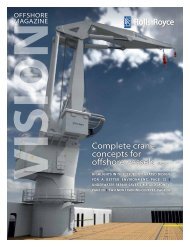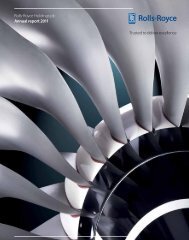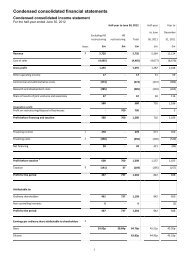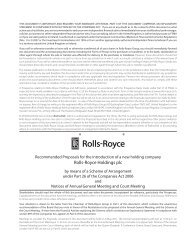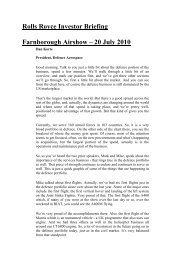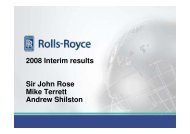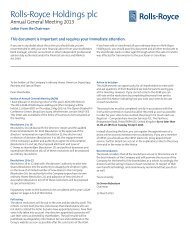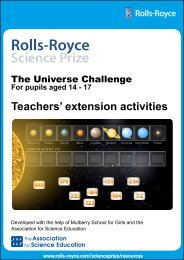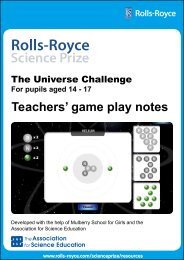Engineering Laboratory and Rig Design - Rolls-Royce
Engineering Laboratory and Rig Design - Rolls-Royce
Engineering Laboratory and Rig Design - Rolls-Royce
You also want an ePaper? Increase the reach of your titles
YUMPU automatically turns print PDFs into web optimized ePapers that Google loves.
Primary circuit relief valves rig<br />
Valve test facility<br />
The valve test facility (VTF) works in the development <strong>and</strong> production<br />
testing of valves for use on the nuclear reactor plant using high temperature<br />
high pressure water. The rig is capable of performing functionality tests on<br />
the following valves: hydraulically operated, pneumatically operated, oil<br />
operated, electrically operated <strong>and</strong> manual valves.<br />
Control rod test facility<br />
The control rod test facility comprises 3 rigs:<br />
Hot CRTF rig – This rig is used to test control rod drive mechanisms<br />
(stators, upper drive mechanisms <strong>and</strong> position indicators) in a pressurised<br />
heated vessel. The rig is capable of testing at NSRP conditions, ie high<br />
temperature <strong>and</strong> pressure. The rig is mainly used to perform development<br />
<strong>and</strong> prototype testing <strong>and</strong> was used for the new generation of upper<br />
mechanism containing out-motion <strong>and</strong> rebound latches.<br />
In air CRTF rig – This rig is used to perform the same functionality tests of<br />
CRDMs as the hot CRTF rig without the need to immerse the components<br />
in a pressurised vessel. This rig is used to carry out production testing of all<br />
CRDMs that are fitted to the nuclear submarine fleet.<br />
Position indicator rig – This rig is used to carry out electrical calibration<br />
of production position indicators. These components are used on the<br />
submarine to indicate the position of all the fuel rod in the reactor<br />
pressure vessel during operation.<br />
Heat transfer rig<br />
The heat transfer rig is used to provide experimental data to validate the<br />
thermal <strong>and</strong> hydraulic mathematical models used for the design <strong>and</strong><br />
safety justifications of pressurised water reactor (PWR) cores. To date,<br />
the rig has been used to develop PWR1, SWR <strong>and</strong> PWR2. A test section,<br />
representing a reactor core cooling channel, is fitted between insulating<br />
flanges. Heated, pressurised water is passed through 6”, 2”, or ½” lines<br />
into the test cell. A series of tests is carried out where the parameters of<br />
fluid flow rate, temperature <strong>and</strong> pressure drop are measured as power<br />
is increased via a 2MW DC power supply through the test section. The<br />
aim is to find an operating envelope within which the heat transfer<br />
mechanism remains intact, <strong>and</strong> the structural integrity of the test section<br />
is maintained. The rig has also been adapted to test compact heat<br />
exchanger units for the oil industry <strong>and</strong> perform tests on stator can units<br />
for the Ministry of Defence.<br />
Primary circuit relief valves (PCRV)<br />
Installed, upgraded <strong>and</strong> commissioned in Sept 2006. The PCRV rig tests<br />
relief valves at high temperature <strong>and</strong> pressures. The test rig mainly<br />
comprises a steam generator (boiler), 3 large accumulator vessels, stainless<br />
steel pipework <strong>and</strong> valves, a discharge tank <strong>and</strong> a modern control room. To<br />
supplement the rig pressure once temperature has been attained, a high<br />
pressure nitrogen system is incorporated which provides the necessary<br />
surge to lift the valve at test.<br />
<strong>Rig</strong>s team<br />
The team provide complete solutions for the design, implementation<br />
<strong>and</strong> testing of rigs. In addition, we also have the capability to<br />
design mechanical h<strong>and</strong>ling systems, jigs <strong>and</strong> tools, <strong>and</strong> automated<br />
inspection systems.<br />
Test rigs<br />
<strong>Rolls</strong>-<strong>Royce</strong> has considerable experience in the design <strong>and</strong><br />
implementation of mechanical test rigs (used for testing components) <strong>and</strong><br />
fluid flow rigs (used to underst<strong>and</strong>ing of flow regimes within components<br />
<strong>and</strong> systems).<br />
The <strong>Rolls</strong>-<strong>Royce</strong> engineering laboratory <strong>and</strong> test rig team, has the<br />
capability <strong>and</strong> experience to produce bespoke test rigs to operate at both<br />
ambient conditions <strong>and</strong> high pressure <strong>and</strong> temperature environments.<br />
Working closely with the customer at all times, our specialist team design<br />
specific test requirements <strong>and</strong> then develop solutions to meet customer<br />
expectations.<br />
The team offers full rigs service from conception to final h<strong>and</strong>over to the<br />
customer. Additionally, we provide full support after delivery including<br />
upgrades <strong>and</strong> modifications where necessary to maintain st<strong>and</strong>ards <strong>and</strong><br />
support ongoing test development.<br />
7406/SO.24/Nov10<br />
<strong>Rolls</strong>-<strong>Royce</strong> Power <strong>Engineering</strong> plc<br />
PO Box 2000, Derby DE21 7BD, Engl<strong>and</strong><br />
Tel: +44 (0)1332 632688<br />
Fax: +44 (0)1332 622936<br />
Email: nuclearsolutions@rolls-royce.com<br />
www.rolls-royce.com<br />
© 2010 <strong>Rolls</strong>-<strong>Royce</strong> plc<br />
Whilst this information is given in good faith, no<br />
warranty or representation is given concerning such<br />
information, which must not be taken as establishing<br />
any contractual or other commitment binding upon<br />
<strong>Rolls</strong>-<strong>Royce</strong> plc or any of its subsidiary companies.




